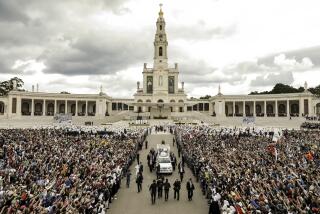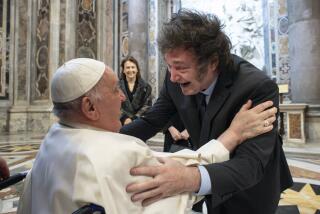Catching the Spirit : More than 500 faithful mark the 1531 appearance of the Virgin Mary before a Mexican peasant whom she instructed to build a church.
SANTA ANA â Among the more than 500 Catholics who turned out for the annual procession honoring Our Lady of Guadalupe on Sunday, few had a better seat than 3-year-old Yazir Gomez.
*
Perched on his fatherâs left shoulder, Yazir looked in awe at the parade of dancers, musicians and holy men, all celebrating the Virgin Maryâs apparition in Mexico in December, 1531.
Of course, Yazir understood little of the festivitiesâ religious meaning, but that will come later, said his father, Mucio Gomez, 28, a truck driver who lives in Santa Ana.
âMy mother and father took me when I was young like him--too young to understand,â said Gomez, who grew up in the Mexican city of San Luis Potosi. In time, young Yazir will come to understand, he said, âthat this is an important day for us.â
The parade, which took place under a clear blue sky in downtown Santa Ana, began at Broadway and 4th Street, and proceeded eastward four blocks to the heart of the Fiesta shopping district.
Dancers wearing Aztec headdresses, red vests and strings of bamboo shoots shook maracas and danced in circles to lead the parade. Behind them were two mariachi bands, and 16 girls wearing floral-print dresses, braided ribbons in their hair, and bright makeup on their faces.
Parishioners from five local Catholic churches marched under colorful banners, and behind them were leaders of Orange Countyâs Catholic diocese, including Bishop Norman F. McFarland of the Diocese of Orange.
The groups sang and clapped as they walked, but paused at each intersection to watch reenactments of the miracle they had gathered to celebrate.
According to teachings of the church, the Virgin Mary appeared in Mexico before an Indian peasant named Juan Diego. The Virgin, who had brown skin and called herself Guadalupe, instructed Diego to build a church on Tepeyac hill, just northwest of Mexico City, in her honor.
But the local bishop did not believe Diego had witnessed an apparition of the Virgin until Diego returned from a fourth meeting with Guadalupe bearing a robe full of roses she had instructed him to gather. When Diego opened this robe before the bishop, the flowers tumbled out, revealing the image of Guadalupe in the empty cloth.
The bishop reportedly fell to his knees, and later set about building the Basilica of the Lady of Guadalupe, which still stands today and remains the home of the sacred robe.
At the conclusion of Sundayâs procession, men and women laid flowers at the foot of an image of Guadalupe painted on tiles embedded in the outside wall of a bakery on Spurgeon Street.
Msgr. Jaime Soto, who serves as the liaison between the diocese and the Latino community in Orange County, said the celebration is a day of pride for Mexican Catholics.
âShe appeared as an Indian woman, and this miracle is a great sign to us of our dignity,â Soto said. âWithout distinction of race, whether citizen or immigrant, we can feel at home in the Americas.â
Sundayâs celebration has become an Orange County tradition, but the holiday is officially observed each year on Dec. 12, following nine days of prayer, Soto said.
More to Read
Sign up for Essential California
The most important California stories and recommendations in your inbox every morning.
You may occasionally receive promotional content from the Los Angeles Times.










